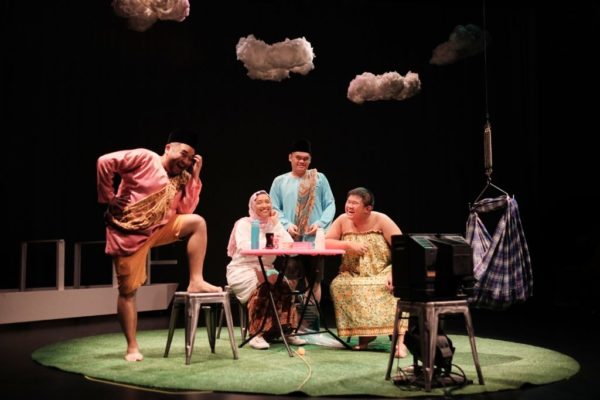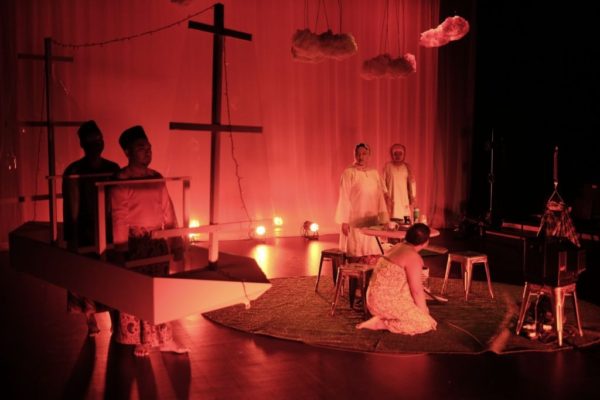Disclaimer: The author would like to highlight that this review was written by a Chinese who does not understand Malay. As such, some cultural intricacies may be lost. This topic, as well as some personal thoughts on the implications and limitations of language, will be further discussed in the review.
Written by Cheryl Tan, edited by Teo Dawn
Angkat: A Definitive, Alternative, Reclaimed Narrative Of A Native was initially conceptualised in 2015 and has since gone through several developmental rounds of workshopping and redrafting. In this latest version of Angkat, playwright Nabilah Said, director Noor Effendy Ibrahim, and dramaturg Zulfadli Rashid bend and blend fact and fiction. This is coupled with Bani Haykal’s mesmerising instrumental sound design, Emanorwatty Saleh’s imaginative lighting design in an imaginative set featuring cotton wool cloud lights, patches of grass, and a large life-sized white wooden boat crafted collectively by the team. The vision of the creative team goes into the telling of the imagined past, present and future to the audience. Angkat explores the stories of a mother and daughter trying to find themselves and where they come from in the midst of changing political, geographical, and social landscapes.
‘Angkat’ in Malay means ‘to carry’; the term ‘anak angkat’ is used to refer to an adopted child. Angkat tackles the issues that often lie hidden within narratives of adoption — familial, racial, and even national. With stories that intertwine in a non-linear narrative, Angkat parallels familial and racial displacement alongside national and geographical displacement.

DISPLACEMENT FOLLOWING MOMENTS OF ANGUISH
The retelling and piecing together of a national historical narrative from fragments of accounts as its overarching theme, Angkat addresses the national narrative in imaginative scenes interspliced throughout the play. This presents the story of a nation displaced. Singapore in many ways, was ‘adopted’ too — namely by Malaysia for a short tumultuous period and then ‘un-adopted’ overnight. We dealt with the displacement within the means of being adopted from 1963 to 1965. The subsequent displacement from Malaysia threw us into a state of disarray and confusion almost comparable to that of displacement of a child from family to foster family.

RACIAL & FAMILIAL DISPLACEMENT
Salma (Shafiqah Efandi), an adopted child and aspiring singer enrols into a national talent competition – a concept we may be familiar with, National Idol. She then finds her identity and history under scrutiny. Adding on to the story, her performance and vocals were nothing short of enchanting.
For some, adoption brings issues of displacement and confusion. In Salma’s story, her adoption also involves ethnicity (inability to speak Malay as fluently as other native speakers and who looks almost… Caucasian) and with it, her struggle to understand who she is where she is. Meanwhile, people place expectations on her to behave and be what they would expect of a Malay singer. For some, being adopted may pose issues that are difficult to reconcile with. For others, these issues compound further when there is not a shared ethnicity between the adoptee and his or her parents. This is a story that often goes unheard of, and one that desperately needs to be told. As such, Angkat brings to light the tension that lies within when a person’s skin tone betrays the ethnicity and lifestyle she or he has been brought up in.

NATIONAL & GEOGRAPHICAL DISPLACEMENT
In Angkat, adoption extends far beyond its usual familial definition. What happens when you find yourself on unfamiliar shores after being displaced from home, uncertain of how to make a living in a land that betrays familiarity and comfort?
This is the story of Mak (Moli Mohter), whose home was a small island off the coast of Singapore, and who then arrives on the mainland. She navigates her current displacement, and copes with the loss of her home by recounting her past memories to her friends — a charming trio played by Adib Kosnan, Hafidz Abdul Rahman, and Izzul Irfan. Throughout the show, the trio charm audiences with their maniacal hilarity and tight chemistry, infusing wondrous energy and life into the production.

Along the way, and guided heavily by surtitles due to my inability to understand conversational Singaporean Malay, I started to realise that the jokes cracked by the trio were funny because of their powerful delivery on the part of the actors, and did not make much sense when translated directly into English. It was later mentioned during the post-show dialogue that the production team chose to leave the surtitles as direct translations although they lacked the semantic intricacies of the Malay language, simply because there is so much linguistic richness of a language that cannot be translated over into a different one.
For a play about ‘Malay-ness’, not being to understand the Malay language itself heightened Angkat’s experience for me — that there were punchlines and cultural references conveyed through language that I could sense the humour of from hearty laughs from Malay-speaking audience members, but that I was clearly missing, only served as a reminder of how much we have yet to understand about each other, especially amongst different languages, races, and religions. I realised that this incomprehension goes beyond not being able to understand jokes told in Malay, and delves into the incomprehension of what it means to be raised in this particular ethnic sphere.
Through conversations with friends (some of whom I have been privileged to work with regarding issues of race and who have also worked on this show) and through Angkat, I’ve come to understand that there are Malays, and then there are Singaporean Malays. The experience of growing up on this sunny island as conveyed through Angkat seems specific to what Singaporean Malays would identify with. This, like many other stories, is only one narrative of what it might mean for Malays to be displaced in Singapore, and while it is by no means the only one, it will by every means always be an important one worth striving to learn and understand better.
Photography credit: MonoSpectrum Photography
==
Stay updated and social with Popspoken: Telegram| Facebook | Twitter | Instagram







